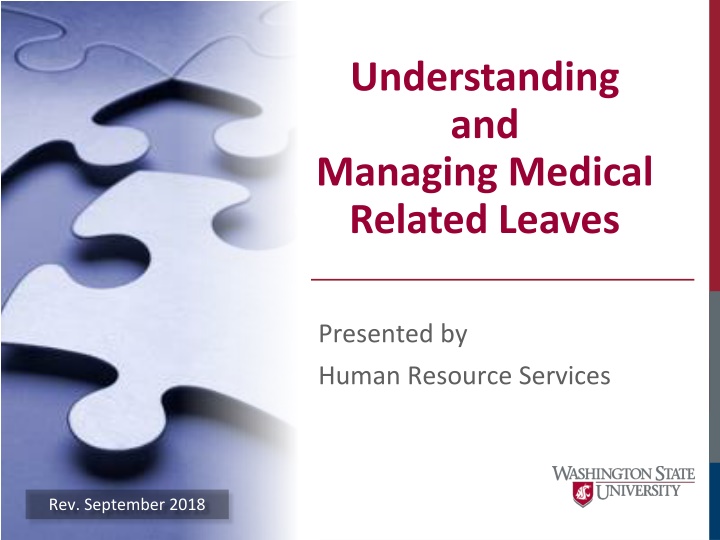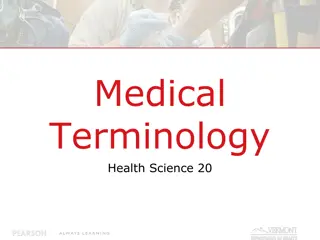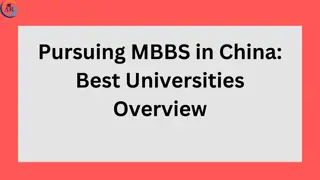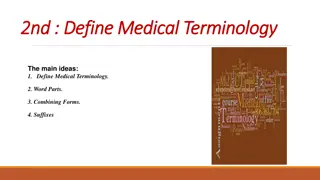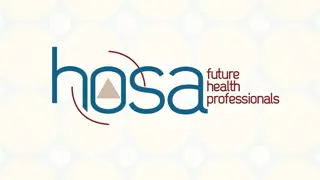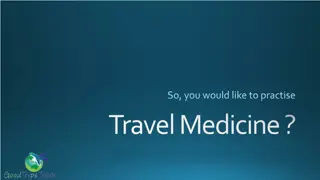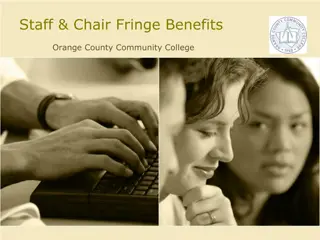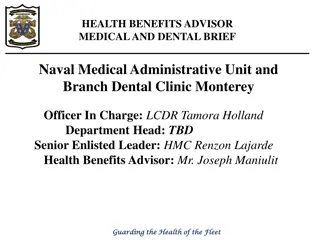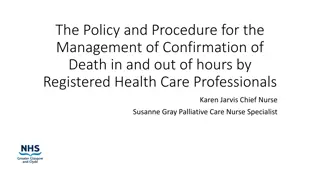Managing Medical Leaves: Comprehensive Guide for HR Professionals
This presentation delves into understanding and managing different types of medical-related leaves in the workplace, covering various leave provisions, benefits provided by law and policies, interplay between provisions and leave types, general rules for using leave, and specifics of Family Medical Leave. It outlines different scenarios under which employees can take medical leaves and highlights the importance of proper documentation and adherence to policies for effective leave management.
Download Presentation

Please find below an Image/Link to download the presentation.
The content on the website is provided AS IS for your information and personal use only. It may not be sold, licensed, or shared on other websites without obtaining consent from the author.If you encounter any issues during the download, it is possible that the publisher has removed the file from their server.
You are allowed to download the files provided on this website for personal or commercial use, subject to the condition that they are used lawfully. All files are the property of their respective owners.
The content on the website is provided AS IS for your information and personal use only. It may not be sold, licensed, or shared on other websites without obtaining consent from the author.
E N D
Presentation Transcript
Understanding and Managing Medical Related Leaves Presented by Human Resource Services Rev. September 2018
Objectives How to manage medical related leaves Avoiding pitfalls
Leave Types Available Annual Leave Sick Leave* Leave Without Pay (LWOP) Compensatory Time Personal Holiday Shared Leave Leave Provisions Available Family Medical Leave Extended Leave - RA Family Care Leave Disability Leave Military Family Leave Family Leave Act - Parental Leave Domestic Violence Leave
Medical Leave Benefits provided according to Federal Law State Law (RCW) WAC/Collective Bargaining Agreements University Policy AP Handbook / Faculty Manual
Interplay between Leave Provisions and Leave Types Leave Provisions Leave Types Workers Comp. Family Medical Leave (FML) Leave Accruals Disability Leave Shared Leave Family Care Leave (FCL) Leave Without Pay (LWOP) Leave as a Reasonable Accommodation (RA)
Using Leave General Rules Questions? Check the appropriate Policies Sample: BPPM 60.56 & 60.57
Family Medical Leave Federal Provision Job and Benefits protected leave 12 weeks/480 hours of leave, in a rolling 12 month period, for a full-time employee for qualifying event HRS determines eligibility
Family Medical Leave Qualifying Events: Employee s serious health condition Birth, adoption, or placement of a child (Parental Leave) Care for a qualifying family member (child, parent, spouse) with a serious health condition
Family Medical Leave Employee chooses how to use accrued leave or LWOP Leave can be for a block of time, reduced work schedule, or used intermittently All based on supporting medical documentation
Family Care Leave State Provision Care for an eligible family member Extends only as long as paid leave is available. Full-pay status required Eligible Family Members include: spouse, child, parent, parent-in-law, and grandparent
Family Leave Act State Provision FLA is available to FML eligible employees FLA Parental Leave is for non-medical baby/child bonding Up to 12 weeks of Parental Leave (in addition to FML for medical reasons) May be used within the first year after birth, adoption, or placement of a child FLA may be denied by a department on the basis of business necessity (consult HRS DS)
Parental Leave FML and Family Leave Act interaction
Paid Sick Leave Temporary Hourly Employees State Provision Temporary hourly employees begin accruing PSL on the first day of a new appointment. PSL accrues at the rate of one hour for every forty hours worked, including overtime hours. Hours worked do not include PSL hours used Notice: Departments are required to provide Notice to employees no later than the first day of the appointment
Paid Sick Leave Temporary Hourly Employees State Provision Usage For own or family member s health condition When WSU has been closed by order of a public official for any health-related reason, or when an employee s child s school or place of care has been closed for such a reason For absences that qualify for leave under the domestic violence leave act Forward medical documentation to HRS
Disability Leave University Provision Non-FML eligible employees: FULL-TIME leave for their own condition, up to total of 4 months FML eligible employees: Additional month of insurance benefits beyond FML period when an employee is out full time (4th month)
Domestic Violence Leave State Provision Allows victims of domestic violence, sexual assault, or stalking to take reasonable leave from work: To take care of legal or law enforcement needs and obtain health care Family members may take leave to help victim obtain help Paid or unpaid
Medical Leave Requests Your responsibility as a supervisor is to: Identify a request, or potential need Sample notice triggers to refer employee to HRS are: I need to be out every now and then for my/my family member s medical condition I m/We re having/adopting a baby I am/My family member is going to need surgery
Medical Leave Other Notice Triggers Other Medical leave needs triggers Employee calls out for over three days Employee was hospitalized Consistent use of sick leave or other leaves for sick reasons Suspicious use of sick leave or other leaves for sick reasons BPPM 60.56, 60.57
FML: What you Can and Cant Say Can Ask them if time is for FML Can t Deny leave at any time Put on notice, do nothing Ask what condition is, specifics Retaliation, off-hand comments
Leave Types Shared Leave RCW 41.04.660 BPPM 60.58 Allows state employees to donate their annual leave, sick leave, or personal holidays to another state employee who meets Shared Leave criteria.
Shared Leave Extraordinary or severe Called to Uniformed Services Employee is or is spouse of person in uniformed services or is a veteran attending medical appointments Emergency volunteer service during state of emergency The employee is a victim of domestic violence, sexual assault, or stalking Pregnancy disability or Parental leave Foster Parent
Workers Compensation Injury or Occupational Disease that has a . . . Proximate Cause which occurred during . . . Course of Employment or Volunteer work
Workers Compensation Washington State Department of Labor and Industries (L&I) No fault insurance Priority is placed upon returning to work in any capacity
Benefits of Workers Compensation Approved medical care (100%) Employee wage replacement (60-75%) Return-to-work assistance Other long term benefits (partial permanent disability, pensions etc.)
Supervisor / Department Responsibilities Ensure first-aid and/or medical treatment is provided. If required - Call 911 Arrange for ride to hospital/doctor as necessary Have WSU Online Incident Report completed within 24 hrs. Refer to HRS DS
Supervisor / Department Responsibilities Immediately report accidents which result in death, amputation, or serious injury according to policy (SPPM 2.24) Interview the injured worker and any witnesses ASAP
Filing an L&I Claim If an employee chooses to file an L&I claim they do so through medical provider, online, or over the phone. Different process than Incident Report WSU may question the claim validity if: Not covered by law, nor work related, questionable based on situation etc. Notify HRS immediately if concerns with incident
Workers Compensation and Leave Not kept on salary Employees use own accrued leaves to maintain WSU pay Must use 8 hours of pay in a month to maintain benefits under FML and DL leave provisions
Return To Work Coordination Goal is to return injured workers to the workforce asap HRS Pullman coordinates WSU portion of all claims
Return To Work Coordination Do not change job duties due to illness or injury. Could potentially informally accommodate. Talk to HRS. NOTE: Duties reviewed are from position descriptions on file with HRS. It is imperative these are accurate.
Temporary Modified Duties If normal job is impacted by limitations, can the job be temporarily modified? Examples of Temporary Modified Duties: Part-time/alternate schedule. New duties - same knowledge. Change building or location. Different equipment or work methods. Special projects. Other duties within position description.
Reasonable Accommodation
Reasonable Accommodations (RA) WSU will provide RA for a known physical, mental, or sensory limitation Employee must be able to perform the essential functions of the position with or without an RA
Not a Qualified Disability Non-chronic condition Sprain, broken limb, flu Current illegal drug use Active alcoholism or abuse
Types of Accommodations Facility modifications or location change Work space modifications Acquiring or modifying equipment or devices
Types of Accommodations (cont.) Work area equipment purchase Work schedule modifications Extended leave (consistent with law) Reassignment to an open, vacant, recruited position
RA Process Overview Identification - by the employee, the supervisor or a health care provider Documentation - medical certification normally required Accommodation - HRS will work with the department and the employee to review the request and possible options
RA Stages - Review 1. In collaboration with department: Capabilities and limitations Position description and job functions Departmental needs 2. HRS contacts and works with other WSU or external partners as needed: Environmental Health and Safety Capital Planning Job coaches
RA Stages - Decision If an RA is identified: 1. Appointing Authority approves the RA 2. HRS documents accommodation 3. Review date established If no RA is identified: 1. Full review and vetting process 2. HRS determines next steps in accordance with laws, rules and University policies
Undue Hardship Not based solely on departmental funds, it is more global. No central funds for accommodations. Light duty and/or extended medical leave are RARELY undue hardships.
Department Responsibilities What to do Notify HRS of the possible need for leave/RA. Keep conversations private. Be an active, constructive participant in the leave and RA processes. Accommodate through the official RA process.
Department Responsibilities What Not to Do Do not informally accommodate. Do not make job changes based on employee provided information regarding a medical condition without engaging HRS. General Examples: Changing the employee s essential functions. (Over time or even if identified as temporary) Providing equipment. Moving their office. Adjusting their schedule/work structure.
Disability Services Coordination Medical/ Disability Leave FML RA WC Interplay between these leaves is complicated. HRS is here to help you manage the process.
Resources BPPM 60.56 and 60.57 Leave BPPM 60.21 Reasonable Accommodation BPPM 60.58 Shared Leave BPPM 60.81 Volunteers BPPM 60.43 Paid sick leave for Temp/Hrly SPPM 2.24 Reporting Accidental Injuries Illnesses Administrative Handbook. Faculty Manual Collective Bargaining Agreements Access Center -Student accommodations Office of Equal Opportunity (OEO) EEO/AA compliance Disability discrimination. WSU Accessibility - ADA Coordinator.
Questions Human Resource Services Disability Services hrs.wsu.edu/Disability-Services 509-335-4521 or hrs@wsu.edu
This has been a WSU Training Videoconference If you attended this live training session and wish to have your attendance documented in your training history, please notify Human Resource Services within 24 hours of today's date: hrstraining@wsu.edu
